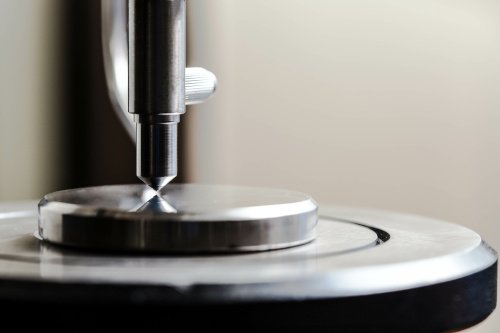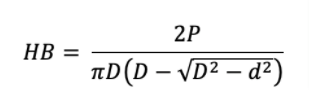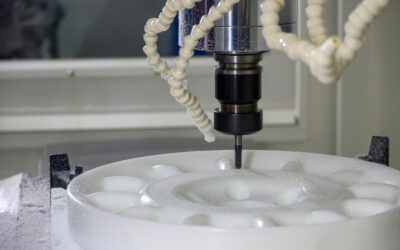The product development process encompasses several minor processes, and material selection is the most essential among them.
Every material has different mechanical properties and capabilities. And to make the right material choice, you need to determine the type of loading conditions your part will experience. For instance, if you’re looking to design a part (or assembly) that will make contact with other components or experience impact loading, then you want to choose a material with sufficient material hardness.
But what exactly is material hardness, and how do you measure it? This article answers these questions and more.
What is Material Hardness?
Material hardness is the ability of a material to withstand localized plastic deformation due to concentrated applied loads.
Look at it this way. When we say a material has a high degree of hardness, it simply means the material can retain its shape in the presence of external forces like scratching, indentation and abrasion. So, materials like titanium and diamond would have a higher degree of hardness than plastic.
When comparing diamond and plastics, you probably know which material has greater hardness by intuition. But when you want to choose between closely related metals (or alloys), it’s almost always impossible to make a correct guess unless you perform a hardness test on them.
There are several methods for testing material hardness. But before we discuss these methods, it’s essential that you first understand the types of material hardness.
Types of Material Hardness
Here are the three types of material hardness:
- Indentation hardness
- Scratch hardness
- Rebound hardness
Indentation hardness refers to the resistance of a material to permanent deformation when it is subjected to continuous load. In contrast, scratch hardness describes a material’s ability to resist scratching of its surface due to contact with another metal. Lastly, rebound hardness is related to the material’s elasticity; it describes the ability of a material to absorb the impact energy.
Once you know the type of loading (or environmental) conditions your part will experience, you can then consider any of the following hardness test methods to compare your material options. If you have the equipment necessary, you can complete these tests. Or you can rely on information from your suppliers and online resources like Matweb that list the properties of various materials.
How to Test the Hardness of Materials: 4 Test Methods
Method #1 The Brinell Test

A Brinell Hardness tester from Wikimedia Commons.
The Brinell test measures a material’s indentation hardness. This test method uses an indenter (usually a hardened steel ball) to create an impression on a test piece. In this test method, you will hold the indenter in place before applying a predefined force into the ball (and surface of the material) for a specified period.
Next, assign a Brinell hardness number to the material depending on the size of indentation formed on it. You can measure the indentation using a microscope and calculate the Brinell hardness number using:
Where:
HB = Brinell hardness (kg/mm2)
P = Force (measured in Newton)
D = Indenter diameter (measured in millimeters)
d = indentation diameter (measured in millimeters)
However, keep in mind that the predefined force you will apply on the indenter depends on the material you’re looking to test. For instance, quality control experts typically use a standard load of 3000 kg (or 30,000 N) for hard metals like iron and steel. In contrast, you should apply a load of 500kg (or 5000 N) for softer materials like copper and brass.
Method #2 Rockwell Hardness Test
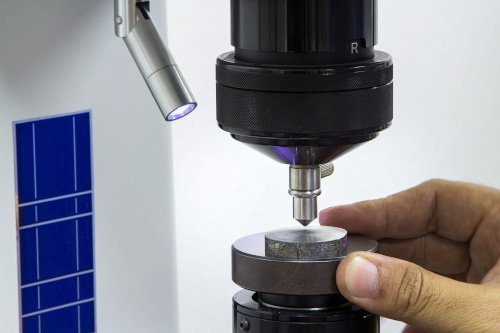
Operator conducting a Rockwell hardness test
Like the Brinell hardness test, the Rockwell hardness test is also used for indentation hardness measurement and typically involves using an indenter (usually steel ball or a spherical diamond-tipped cone).
However, in the Brinell hardness test, you hold the indenter in place by applying a minor load (typically 10 kg or 100 N) before applying the major test load. Then, upon removing the major load, measure the indentation depth while the minor load is still on.
The hardness number can then be read using different Rockwell hardness scales (A, B, C, etc.). The ideal scale depends on the type of indenter used and the test load applied to the material. For instance, let’s say you want to measure the hardness of steel alloys; you would have to use a diamond cone indenter with up to 140 kg of major load. In such a scenario, you will read the hardness number on the “C” scale.
For softer metals like copper alloys, quality control experts use a diamond steel ball (with up to 100 kg of major load) and read the hardness number on the “B” scale.
Method #3 Mohs Hardness Test
The Mohs hardness test is ideal for measuring the scratch resistance of a material. In this test method, you scratch the material’s surface to be tested using a reference material with predefined hardness. The hardness value is expressed using the Mohs scale, which is composed of 10 minerals that have been assigned arbitrary hardness values.
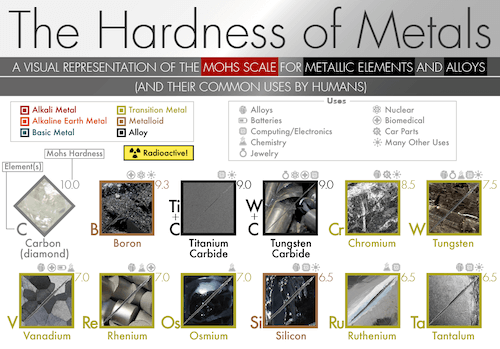
See the full Mohs hardness chart on Alan’s Factory Outlet
Alan’s Factory Outlet has Mohs hardness chart (screenshot above) on which you can see examples of the scratch resistance of various metals.
Method #4 Shore Scleroscope Hardness Test
The shore scleroscope is a device used to measure a material’s rebound hardness. The device features a graduated glass tube mounted on a stand. To determine the rebound hardness of your material, you’ll drop a diamond-tipped hammer through the glass tube onto the material.
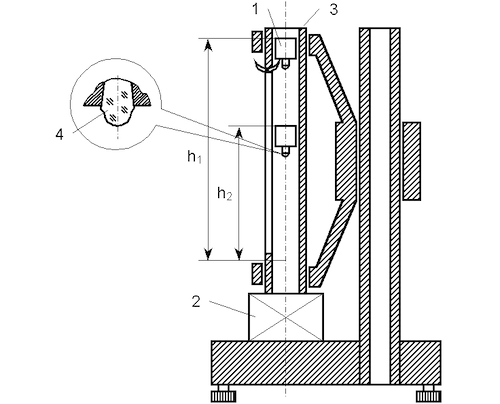
Schematic representation of Shore Scleroscope mounted on a tripod. From Wikimedia Commons.
The hardness value is proportional to the height to which the hammer rebounds after hitting the test piece. For instance, a material with a greater hardness causes greater rebound height than a material with a lesser degree of hardness.
Material Hardness Test and Product Development: Gensun Precision Machining Services
Without a doubt, it is essential to know the hardness of different materials to determine the ideal material for your product design. But even after you choose a suitable material for your product, you still have to find a suitable machine shop and machinist capable of creating your parts accurately and precisely.
Gensun Precision Machining is a leading provider of machining services across Asia. Not only do we have a team of quality control experts capable of testing material hardness, but we also have a team of highly qualified engineers and machinists. Our team of experts works together to create your product accurately and precisely using state-of-the-art machining technologies.
Learn more about our machining services.

